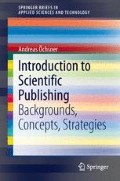Abstract
This chapter covers briefly several topics related to the publishing process in scientific journals. Several stages of the publishing process, starting from the manuscript preparation, to the submission, the review process etc., are briefly explained in order to illustrate the time frame for a publication. Different concepts for the review process, i.e. single-blind, double-blind and open review, are introduced. Several subsections cover different parts of a manuscript. It is not a guideline on ‘how to write a journal paper’ but useful comments and suggestions are provided. The final part of this chapter covers questions related to the submission and revision of a journal manuscript.
Access this chapter
Tax calculation will be finalised at checkout
Purchases are for personal use only
Notes
- 1.
The majority of submissions should not be prepared in the final layout and should contain only very basic formatting features.
- 2.
Final layout refers here to a print or PDF version. In the case of a HTML or EPUB version, there is no final layout but the production unit still must do some editing.
- 3.
It is common that the publishers add numbered lines to ease reference to any passage to be corrected.
- 4.
Each article may simply start with page 1.
- 5.
It is in this case required that the authors prepare a version without authors and affiliations on the first page. However, the author might be disclosed by the literature review or literature section where the own previous work is mentioned.
- 6.
Some of the journals which perform an open peer review publish on the first page of an article the names and affiliations of the reviewers.
- 7.
About 60 % of the submitted manuscripts to Nature are rejected by the editors without further peer-review.
- 8.
Some authors separate an own section for results and afterwards a section on discussion. However, it might be useful to immediately explain the findings where they are presented and described.
- 9.
“
 is a comprehensive set of markup commands used with the powerful typesetting program
is a comprehensive set of markup commands used with the powerful typesetting program  for the preparation of a wide variety of documents, from scientific articles, reports, to complex books”[16]. Writing manuscripts in
for the preparation of a wide variety of documents, from scientific articles, reports, to complex books”[16]. Writing manuscripts in  is similar to HTML programming.
is similar to HTML programming. - 10.
Some recommendations will be different from publisher to publisher. In any case, an author should carefully check the specific instructions for authors for the selected journal or book.
- 11.
Variables of higher dimension with rows and columns.
- 12.
The original name is known in French as: Système International d’Unités.
- 13.
More information on units can be found in the brochures of the Bureau International des Poids et Mesures (BIPM): www.bipm.org/en/si.
- 14.
However, color figures are nowadays available in the online version of journals.
- 15.
Some of these criteria can be simply checked in the scientific databases, see Chap. 5.
References
Lebrun J-L (2007) Scientific writing: a reader and writer’s guide. World Scientific Publishing, Singapore
Gould JR, Losano WA (2008) Opportunities in technical writing careers. McGraw-Hill, New York
Matthews JR, Matthews RW (2008) Successful scientific writing—a step-by-step guide for the biological and medical sciences. Cambridge University Press, Cambridge
Winkler AC, McCuen-Metherell JR (2008) Writing the research paper: a handbook. Wadsworth, Cengage Learning, Boston
Terheggen P (2010) Elsevier introduction and how to get published in scientific journals. http://www.paperpub.com.cn/admin/upload/file/2010913155015585.pdf. Cited 13 September 2012
McGowan D (2012) How to write for and get published in scientific journals. http://www.slideshare.net/ytaki/how-to-write-for-and-get-published-in-scientific-journals-edanz19052011. Cited 13 September 2012
Pickett NA, Laster AA, Staples KE (2001) Technical English: writing, reading and speaking. Pearson Education, Essex
Brieger N, Pohl A (2002) Technical English: vocabulary and grammar. Summertown Publishing, Andover
Creme P, Lea MR (2003) Writing at universities. Open University Press, Berkshire
Earnshaw S (2007) The handbook of creative writing. Edinburgh University Press, Edinburgh
Bartoszyński T, Shelah S (2002) Strongly meager and strong measure zero set. Arch Math Logic 41:245–250
Birukou A, Wakeling JR, Bartolini C et al (2011) Alternatives to peer review: novel approaches for research evaluation. Front Comput Neurosci 5:1–12
Spier R (2002) The history of the peer-review process. Trends Biotechnol 20:357–358
Overview: Nature’s peer review trial (2006). http://www.nature.com/nature/peerreview/debate/nature05535.html. Cited 3 September 2012
Marian Koshland Bioscience & Natural Resources Library—Scientific Literature (2012). http://www.lib.berkeley.edu/BIOS/bio1bscholcomm.html. Cited 11 July 2012
Kopka H, Daly PW (2004) A guide to LATEX: and electronic publishing. Addison-Wesley, Harlow
Author information
Authors and Affiliations
Corresponding author
Rights and permissions
Copyright information
© 2013 The Author(s)
About this chapter
Cite this chapter
Öchsner, A. (2013). Publishing in Scientific Journals. In: Introduction to Scientific Publishing. SpringerBriefs in Applied Sciences and Technology. Springer, Berlin, Heidelberg. https://doi.org/10.1007/978-3-642-38646-6_7
Download citation
DOI: https://doi.org/10.1007/978-3-642-38646-6_7
Published:
Publisher Name: Springer, Berlin, Heidelberg
Print ISBN: 978-3-642-38645-9
Online ISBN: 978-3-642-38646-6
eBook Packages: EngineeringEngineering (R0)


 is a comprehensive set of markup commands used with the powerful typesetting program
is a comprehensive set of markup commands used with the powerful typesetting program  for the preparation of a wide variety of documents, from scientific articles, reports, to complex books”[
for the preparation of a wide variety of documents, from scientific articles, reports, to complex books”[ is similar to HTML programming.
is similar to HTML programming.